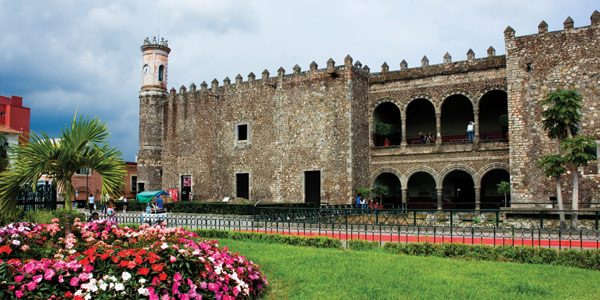In Cuernavaca, Mexico, a progressive language school provides LGBT and women’s programs
Our teacher, Lety, is a sturdy butch with a ready smile. She stands beside a whiteboard and covers it with words and pictures that illustrate Mexico’s derogatory but colorful gay and lesbian slang. Mariposa is the word for butterfly and for a gay man. Lesbians are thought to wear only blue jeans, so their nickname is Levi’s in Spanish, Livais—and, more specifically, quinientos uno, for the original 501 style.
I never thought I’d learn these things in a classroom, but this is no ordinary Spanish class. Cetlalic (cetlalic.org.mx), or the Tlahuica Centre for Language and Cultural Exchange, takes its name from the city’s original inhabitants, whose own language is seriously endangered. The center was founded in 1987 as an alternative to the mainstream schools that were drawing thousands of tourists to Cuernavaca.
There are almost 40 full- and part-time Spanish schools in the city, which are located in the mountains just south of Mexico City. Students are drawn to this location for the climate (Cuernavaca is called the City of Eternal Spring), the parks and the culture. Cetlalic favors a teaching method it calls Popular Education, emphasizing participation and dialogue rather than rote learning. Special curriculums are offered throughout the year, including women’s and LGBT studies.
“Twenty-five years ago, I met Holly Near,” says school director Jorge Torres, referring to the activist singer, “and she had a big influence on me.” The teaching staff, most of whom were straight, did workshops to learn about gay and lesbian realities, and in the mid-1990s the first queer program was launched. I’m visiting the Winter LGBTQ Program, which runs at the same time as Women and Social Change in Mexico. The summer program offers students a chance to participate in Mexico City’s Pride march.
Gay and lesbian students and friends ham it up with their teacher, Lety (center)
The slang we are learning today seems crass compared to the lofty ideals of Cetlalic, but it shows what Mexican gays and lesbians have to contend with. The discussion ends with some role reversal as we teach American slang to our teachers, who struggle with the flat r’s, to our amusement.
We go back to our homestays armed with more insights into Mexican life. My host is a lesbian who lives with her four dogs in a comfortable house in the north end of the city. We go out to meet her younger girlfriend and my host tells me that at the age of 25 she had a long-term relationship with a 55-year-old woman, so now she’s enjoying the other side of an intergenerational match.
Many Cetlalic students choose the homestay option, and every morning I hear them raving about the hospitality and the delicious cuisine they’re enjoying. But in the evening, some of them agonize over how to deal with their housemothers, who actually want to know what time they’ll be home! The school has over a dozen gay, lesbian and bisexual hosts.
The other students in my program include a couple of retired schoolteachers, a gay businessman who likes to sketch portraits of everyone, some activists and a youth worker–drag king. Most are visiting Mexico on their own, combining education and travel. We bond immediately and spend most of our free time together, exploring the city, talking politics and laughing. Most of them speak a halting, grammatically correct Spanish, while I blab rapidly, making mistakes everywhere.

Museo Robert Brady
We study in open-air classrooms surrounded by fruit trees and ferns. My teacher acts out the words, and also helps us understand the subtleties of Mexican culture. I’ve never had so much fun learning the subjunctive.
Morning classes are followed by afternoon charlas (discussions) and outings. We tour the Robert Brady Museum , a tribute to an American artist and collector who filled his home with an astonishing and eclectic art collection, fabulous guests and scandalous rumors. We have a drink at the queer-friendly Barecito Café (facebook.com/barecitocafe), where folk and indie music fills the air. At the home of another artist we meet Lina Rodriguez, a local lesbian photographer and filmmaker who’s working on a movie about women accused of witchcraft in Spain.
Other guest lecturers come to the school, like Trini Gutièrrez, who talks about the history of Mexico’s gay and lesbian movements. It’s interesting to learn that the very first lesbian group met in the home of the legendary activist Nancy Cárdenas, who lived near Cuernavaca. Little did they know how much their movement would grow and flourish, and that someday travellers would journey to this city from all over the world to study Spanish and be part of their community. (visitmexico.com)
If You Go
Enrollment at all the Spanish schools in Cuernavaca has gone down since my visit due to reports of drug-related violence in the area, but residents believe the city is safe. “The Spanish students that still come to learn the language and the culture, they also learn about the reality,” says Jorge Torres who says there is “exaggeration on the news in [the] U.S. or Canada about the situation in Mexico.” Before traveling, visit travel.state.gov for latest warning updates.
